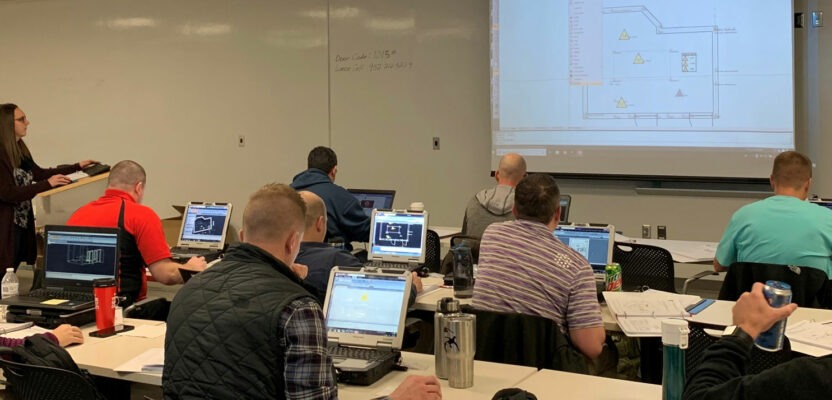It would be stating the obvious that finding qualified surveying staff right now is challenging. Offering training as recruitment/retention incentive is difficult if such opportunities are limited. A renewed focus on creating more training opportunities, within the profession and supporting industries, is changing this.
Training/education as an incentive to recruit and retain survey staff is not new. Some employers will pay for attendance at state surveying conferences, association/society classes to study for a license, Certified Surveyor Technician (CST) courses, CFedS, local seminars, online courses, and even in some cases the big commercial vendor events.
You Know Anyone Looking for Work?
I see postings in surveying forums and groups for fantastic job opportunities, in great places to live and work, going unfilled for many months. I get emails/calls several times a week asking if I know of any surveyors looking for work. In many parts of the country, there simply are few (if any) surveyors that have not been able to find multiple good opportunities. Some of this can be attributed to a pronounced infrastructure boom, that seems even more pronounced in large urban regions; this makes it more difficult for employers in more rural regions to recruit from outside their localities. Sharp competition for staff has led to wage (and other incentive) rises. While this crunch is not the same across the entire country, it is in enough places that many survey firms are struggling to field enough crews, and some tell me they have had to turn down some work.
Surveying has always been a feast-or-famine prospect; the rises and dips in economics are felt sharply within the profession. Surveyors have to surf these waves, often choosing more lucrative opportunities in the high times, and more stable situations in the low, like when competition for public sector positions is high.
The present crunch has not gone unheeded, and many earnest initiatives have been launched or accelerated, by professional associations and supporting industries, for recruitment, retention, succession planning, and upskilling current surveyors. An excellent brief read from a local newspaper in Vermont outlines some of the challenges and efforts to remedy them. There are wonderful initiatives to foster interest in surveying at an early age, like Get Kids into Surveying, Class of Your Own, and many more by local and state surveying associations. These could help tremendously with the long-term recruitment outlook. But, as the profession seems to experience every time we go through each peak time, there can be a struggle to fill positions when they are most needed.
I called some surveying firms in different parts of the country to ask what has worked for recruitment and retention during this shortage. Of course, raising hourly rates was top, but some have looked at ways to leverage non-labor financial outlays as more of an investment than a straight up expense.
Some Carrots
Across the board, the firms I spoke to did not want to show their hand and asked not to be directly quoted, but here are some of their approaches:
- Offer to upgrade equipment, so the recruit/incumbent can get to work with the latest gear. A common example is offering to start a company drone program.
- Hiring folks with little/no surveying experience but offering OJT and formal training.
- Offering training and education incentives mentioned above.
- Offering to send them to the state surveying conference.
- Offering to send them to a big vendor show.
Some talked of one obvious concern; that of folks leaving once they’ve been trained. I heard several different approaches to combat this, often involving an incentive plan that weaves together raises with time and experience, successfully completing certain training/certifications, and sponsoring attendance at conferences/trade shows.

Growth in Training Opportunities
The past few years has seen an explosion in online training opportunities, accelerated in many ways by the pandemic. State and other conferences went fully online for a period, have transitioned to hybrid, and some are just now going fully in-person again. There has been a flood of online webinars and seminars (albeit many that are thinly veiled sales events). There are gems among these offerings, and many employers are willing to grant time to view/attend these, if they are applicable to the type of work done, equipment, or software. Online vendor training, like monthly webinars have seen a sharp rise in attendance. As have surveying education focused podcasts like Mentoring Mondays.
Local dealers have increased their classes offered, and these are almost always hardware/software specific. Employers say they prefer these and the employees seem eager to attend. But there is one training-related opportunity that the employers I spoke with say holds an almost outsized attraction: the big vendor shows held in places like Las Vegas.
The Big Shows
The lure of a vendor conference is multi-fold. There is an opportunity to network with fellow surveyors, see and learn about new gear, hear case study presentations, and frankly to have some fun. And while there have always been at least some focused training sessions at such events, I’ve noticed more of an emphasis on training in some of the planned vendor conferences scheduled for 2022.
One of these is the upcoming HxGN 2022 event. I looked over the agenda it looked like there was more of a focus on training sessions than in previous years. HxGN is the global annual conference/exhibition for Hexagon, the parent company of Leica Geosystems. While there are many large divisions of Hexagon, the one most applicable to surveyors is Geosystems which is pretty much a Leica-centric division. They have named the HxGN 2022 track for this division “Pure Surveying”.
I spoke with Michael Harvey, Lecia Geosystems senior product manager for reality capture, surveying, and engineering for North America, and asked about this increase in training sessions. “Absolutely, we’ve added more,” he said. “We’ve always had training, and hands-on training at our conferences. For instance, at the HDS (high-definition scanning) events.” The HDS events were often week-long intensive training events, which was very popular, especially when scanning was just developing and was not quite as automated as it is today. And at past HxGN events, typically the first day was training sessions. This time the training will be spread across three days, mixed in with other elements of the Pure Surveying track.
Harvey says that the HDS and HxGN events were a place for training, to see presentations by peers about real-world projects using a technology you might be interested in, and “there’s always cross pollination as many ideas get shared.” The training has evolved, to match the growth in end users skills, explains Harvey: “Customers aren’t really struggling as much anymore, they’re thirsting to become better.” From looking at the session summaries in the agenda for the upcoming HxGN 2022 event, it looks less about how to simply operate the gear and what buttons to push, and more about how to refine integrated workflows, manage the massive amounts of data these devices generate, how to process, refine, and analyze.
“We have several rooms at HxGN that will be hands on training, with laptops set up and the customer following the instructor’s lead,” said Harvey. “And there’s other rooms that we have set up for what we’re kind of labeling ‘grow your business’ sessions, more of a lecture type of presentation. We’ll have product experts up there recommending how to best use the tools, how to deploy them, and grow your business.”
And there is an opportunity to go to the exhibit hall, or attend a session presented by folks in the product teams for new gear… sometimes you can talk directly with someone who has the technical expertise to answer your deep-geek questions. While things like the exhibits and ‘grow your biz’ type sessions are not what would be considered formal training, what can be garnered from them, and simply networking with other surveyors, can yield gems that can have a tremendous impact on one’s career and business.
Harvey says that training for their customers is a whole package that includes year-round online classes and resources, canned training videos, dealer-hosted training, etc. This has become di rigueur for surveying product and solutions providers, which is a good thing across the board.
Training in All Forms
Training in the era of rapid evolution in the tech of surveying can take on many hybrid forms; you can glean invaluable nuggets from so many more sources, digital, virtual, educational podcasts, from multiple mentors, even from reverse-mentoring. It’s not just the tech side of surveying that can benefit from non-traditional training. Yes, absolutely, there is no substitute for direct field mentoring on many elements of surveying, but even learning about boundary law and principles can be augmented via new resources. And so can the support from employers for non-traditional training; not only as an incentive to recruit and retain, but as a sound business move.


